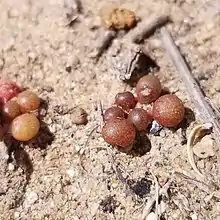Dudleya brevifolia
Dudleya brevifolia,[1][2] is a rare succulent plant known by the common name short-leaved liveforever, short-leaved dudleya or rarely the Del Mar Hasseanthus.[3] It is an edaphic endemic that only grows on the mesas of the most ancient marine terraces, hiding in the vicinity of ironstone concretions. The leaves are deciduous, and disappear after the inflorescence develops. When flowering, it has a conspicuous white flower, which is in the shape of a star with a yellow center. After flowering, any above-ground trace of the plant will disappear, and it survives under the earth with a starch-rich subterranean caudex. It is only found on a strip of coast in San Diego County, California.
| Dudleya brevifolia | |
|---|---|
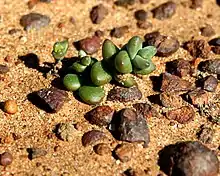 | |
| The nascent inflorescence of Dudleya brevifolia | |
| Scientific classification | |
| Kingdom: | Plantae |
| Clade: | Tracheophytes |
| Clade: | Angiosperms |
| Clade: | Eudicots |
| Order: | Saxifragales |
| Family: | Crassulaceae |
| Genus: | Dudleya |
| Species: | D. brevifolia |
| Binomial name | |
| Dudleya brevifolia (Moran) Moran | |
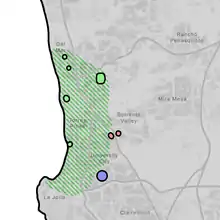 | |
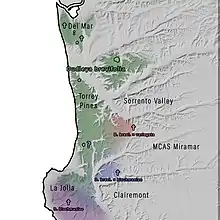 | |
| Natural range of Dudleya brevifolia
green - D. brevifolia
† red - D. brevifolia × D. variegata
† blue - Introgressive populations with D. blochmaniae ssp. blochmaniae | |
| Synonyms | |
It was formerly a subspecies of the similar Dudleya blochmaniae, and was not regarded as distinct enough to be worthy of species-status because both plants grew and hybridized together.[4] However, the rapid urbanization of San Diego led to the destruction of a vast majority of the populations of these plants, with habitats razed to become office parks and suburbs. With the intermediate populations destroyed, it was elevated to species status.[5] Today, it only exists in 5 locations in the world, in an area roughly 8 square miles centered around Torrey Pines State Park. It is of conservation concern, as the populations have become fragmented from each other and are threatened by continued disturbance and destruction.[6]
Description
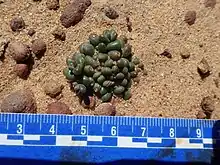
Dudleya brevifolia grows into a somewhat erect, small (1–4 cm), cryptic, and corm-like succulent perennial. It has cone-shaped leaves along its hidden stem. It may be brown, reddish-purple, or greenish.[1] It sprouts after significant winter rains (typically December to February).
It bears a branching inflorescence with a few flowers per branch, each opening into a star-shaped bloom with five pointed petals.[1] The flowering period usually begins as early as April, and continues through June, with seeds being set in June and July. The populations at Carmel Mountain Preserve tend to flower earlier than those near the coast.[7][2]
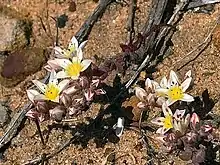
The plant produces a many-seeded fruit from a simple pistil, which disperses seeds along a single suture.[1]
Taxonomy
Taxonomic history
The plant was first collected by F. W. Peirson at Torrey Pines in 1922. Willis L. Jepson, in line with the common scientific view at the time, regarded the plant as a new species of Sedum. Specimens later discovered in the area were unable to be distinguished from Hasseanthus blochmaniae (Blochman's dudleya).[4]
The genus Hasseanthus, now moved into a subgenus of Dudleya, includes plants characterized by a geophytic habit. A 1950 treatment of the plant by Reid Moran would then place it under the subspecies brevifolia of H. blochmaniae, noting some significant morphological differences. The genus Hasseanthus would later become a subgenera of Dudleya.[4]
By 1975, Moran's assessment of the species in the journal Baileya was more grim. Lamenting the "progress of civilization," he reconsidered it as a species in its own right, noting that the destruction of the introgressive populations that graded into Blochman's dudleya made these plants distinct enough to be deemed a species.[5]
Hybridization
Two species of deciduous Dudleya graded into the population of Dudleya brevifolia. Hybrids with Dudleya edulis have also been reported.[8]
D. brevifolia × blochmaniae
One population approached Dudleya blochmaniae at a mesa east of La Jolla. The plants flowered three to four weeks earlier than the other populations of D. brevifolia, and had a different growth habit, being primarily found in depressions on the mesa. Compared to brevifolia, their rosettes and cauline leaves were slightly longer and narrower. The basal leaves and corms approached brevifolia.[9] Moran noted how it was difficult to distinguish brevifolia from blochmaniae until the advent of land development in the area extirpated the populations that transitioned between the two.[4][5]
D. brevifolia × variegata
The plant was also known to grade into Dudleya variegata abundantly at a vernal pool-like depression north of Eastgate Mall road and west of the I-805 near Miramar and the Sorrento Valley.[10][11][3] The location is now an office park.[12] The hybrids possessed intermediate traits.[11][13]
Distribution and habitat
The topography of coastal San Diego County is often challenging for urban development, with steep canyons shearing through flat mesas. The mesas, while suitable for development, were also an important location for vernal pools and other open habitats. Populations of deciduous Dudleya, like the variegated liveforever, Blochman's dudleya, and the many-stem dudleya, are resident to many of the vernal pools and clearings on top of these mesas, with the short-leaved dudleya representing a group localized to the bare surface hardpans of sandstone from Torrey Pines to La Jolla.[4][5]
The plant is endemic to coastal sage scrub habitats in southern California, found only in an extremely limited range within southwestern San Diego County.[2] It is found at Torrey Pines State Reserve in the La Jolla neighborhood of the City of San Diego, and several sites in Del Mar, both coastal communities within the county.[7][14]
It is only found on bare surface hardpans of Torrey sandstone with minimal topsoil, from 30–250 metres (98–820 ft) in elevation.[7] Small marble-sized, ironstone concretions are present at all sites and are likely an edaphic requirement.
Ecology
Phenology
As this plant is a geophyte, occupying a habitat consisting mostly of hardpan substrata, it has an unusual growth habit in which once the tuberous, underground stems hit the hardpan, they will then spread out horizontally along the surface of the impenetrable substrate. In areas with the most shallow soil that is capable of growth, this plant tends to have incredibly irregular stems.[15]
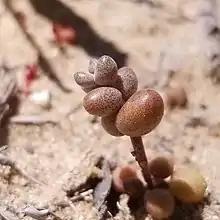
Annual growth begins after the first autumn rains, but this can be disturbed by any mid-winter drought conditions. If the plants are disturbed by any winter droughts, they will return back to dormancy and wait until the next suitable growing season. This is most common in smaller plants, whilst larger plants will usually retain their leaves even through mid-winter droughts. This response may be mistaken for the death of plants, which are in fact dormant underground.[15]
Timing of rains may be more important than the quantity. Years with consistent and evenly spaced autumn-winter rains correlate with the most flowering individuals. Likewise, lack of precipitation in the middle of winter is associated with less plants flowering. In any given year, 10% to 30% of individuals will flower. This means that population estimates made from flowering plants may significantly undercount the number of individuals.[15]
Reproductive biology
This plant may reproduce through seed or via vegetative means. The vast majority of Dudleya species have difficulty in rooting from detached leaves, a trait that distinguished them from Echeveria in early taxonomic studies. In most rosette-forming evergreen Dudleya, the leaves will simply callous, wrinkle, and die.[16] However, some species, especially deciduous ones, may reproduce readily from detached leaves. One to three weeks after the leaves are detached from the plant, roots will emerge from the petiole base.[15]
Seeds are typically dispersed by wind or water. The seeds are small, but are larger in comparison to other members of Dudleya, as plant size is inversely correlated with seed size.[17] The dried inflorescences may detach and tumble along the sandy mesas, which presumably may disperse seed.[15]
Many pollinators make visits to the flowers of D. brevifolia. These include bee flies (Bombyliidae), hover flies, soft-winged flower beetles (Dasytes species, within the family Melyridae), western honey bees, bumble bees and digger bees (tribe Anthrophorini).[15]
Conservation
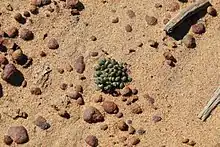
Their population is highly dependent on rainfall, exploding in population when there is annual rainfall over 10 inches, and drastically shrinking when there is less than 4 inches of annual rainfall. The species is seriously threatened by urbanization, vehicles, foot traffic, and fire break construction.[7]
Total population estimates vary by year and by the researcher.[18] Extensive studies have been completed on Carmel Mountain in the Carmel Valley community of San Diego. The Multiple Species Conservation Program (MSCP) of San Diego County estimated the Carmel Mountain population at just 1446 individuals in 2002, and at 113,134 individuals in 2006.[19] Most recently, in 2008, UCLA faculty Dr. Hartmut S. Walter and Matthew Luskin estimated the Carmel Mountain population at over 100,000 individuals.[7][20]
Dudleya brevifolia is a high conservation priority because it exists only in these 5 locations (listed by decreasing average yearly population): Torrey Pines State Reserve, Carmel Mountain (on multiple sites), Crest Canyon, Skeletal Canyon, and Torrey Pines Extension. The total habitat outside of the Torrey Pines State Reserve that contains this species was estimated at just 2,667 square meters.
Endangered species
Dudleya brevifolia is currently listed as an endangered species by the state of California and by the California Native Plant Society.[14][7]
Dudleya blochmaniae subsp. brevifolia was listed as an endangered species by the U.S. Fish and Wildlife Service in January 1982. In October 1996 they withdrew federal protection as an endangered species, citing the threats to the species had diminished and that it was a "covered species" within the Multiple Species Conservation Program (MSCP) of southern San Diego County.[21]
References
- Jepson eFlora: Dudleya brevifolia . accessed 4 July 2016.
- Calflora: Dudleya brevifolia . accessed 4 July 2016.
- Beauchamp, R. Mitchel (1986). A Flora of San Diego County, California. National City, California: Sweetwater River Press. p. 146. ISBN 0-931950-01-5.
- Moran, Reid Venable (1950). "Hasseanthus blochmaniae ssp. brevifolius". Desert Plant Life. 22: 80–82.
- Moran, Reid Venable (1975). "Dudleya brevifolia". Baileya. 19: 146.
- Davitt, Joe (22 February 2022). "Release the Dudleya! Part 1". science.sandiegozoo.org. San Diego Zoo Wildlife Alliance. Retrieved 13 February 2022.
- California Native Plant Society: Inventory of Rare and Endangered Plants (online edition, v8-02) report on Dudleya brevifolia . accessed 4 July 2016.
- Moran, Reid. "Dudleya brevifolia". In Flora of North America Editorial Committee (ed.). Flora of North America North of Mexico (FNA). New York and Oxford. Retrieved 10 February 2022 – via eFloras.org, Missouri Botanical Garden, St. Louis, MO & Harvard University Herbaria, Cambridge, MA.
- Moran, Reid (May 1945). "Notes on Hasseanthus — I". Desert Plant Life. 17: 69–83.
- Oberbauer, Tom (May 19, 1979). "SD104294". CCH1. Archived from the original on 2021-10-06.
- Nakai, K (31 March 1982). "Dudleya brevifolia (Moran) Moran". California Academy of Sciences. Archived from the original on 2014-10-28.
- University Community Plan (PDF). The University Community Planning Group and City of San Diego Planning Department. 2019. pp. 110–111.
- Reiser, Craig H. (July 2001). Rare Plants of San Diego County (PDF). Aquafir Press. pp. 104–105. ASIN B0006F4BAY.
- DFG.ca.gov: Dudleya blochmaniae subsp. brevifolia / Dudleya brevifolia
- Dodero, Mark; Stephenson, Bobbie (April 2005). "Short-leaved Dudleya Enhancement and Restoration Plan for the Carmel Mountain Preserve, San Diego, California". Carmel Mountain and Del Mar Mesa RMP. RECON – via sandiego.gov.
- Thomson, Paul H. (1993). Dudleya and Hasseanthus Handbook. Bonsall Publications. ISBN 978-0960206650.
- Amoroso, D. M., & Wilson, P. (2018). Ten Cases of Divergence in the Seedling Ecology of Dudleya (Crassulaceae). Systematic Botany, 43(4), 889-900.
- USGS.gov: Dudleya blochmaniae subsp. brevifolia
- Sandiego.gov: Dudleya blochmaniae subsp. brevifolia monitoring
- California Native Plant Society, Inventory of Rare and Endangered Plants of California (2001) report of Rare Plant Scientific Advisory Committee, California Native Plant Society. Sacramento, CA. Data tables from electronic copy of the Inventory.
- US-FWS.gov: Dudleya blochmaniae subsp. brevifolia (Endangered species)
External links
- CalFlora Database: Dudleya brevifolia (Short leaved dudleya)
- Jepson Manual eFlora (TJM2) treatment of Dudleya brevifolia — formerly Dudleya blochmaniae subsp. brevifolia.
- USDA Plants profile for Dudleya blochmaniae subsp. brevifolia (shortleaf liveforever)
- UC CalPhotos gallery
| Wikispecies has information related to Dudleya brevifolia. |

